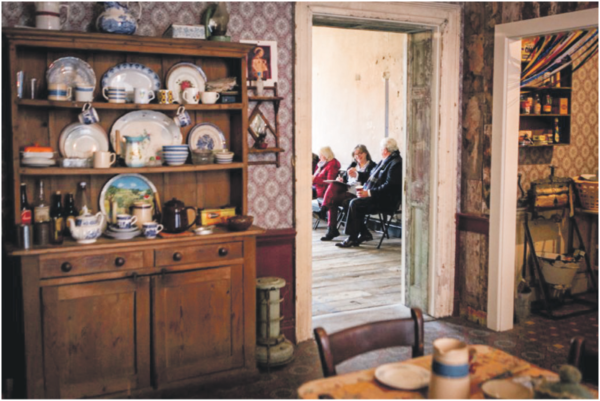
Dermot CarmodyAn initiative this summer from 14 Henrietta Street museum, run by Dublin City Council Culture Company, seeks to encourage Dubliners to share their reminiscences on life in Dublin’s inner city tenements. Where multiple families lived, often in great poverty and terrible conditions, but where tenement dwellers also fondly recall a sense of community which was stripped from the city when people were eventually moved to new housing developments in the suburbs.
Records of tenements in Dublin exist as far back as the 16th century, but it was in the 19th century that the burgeoning and then rotting houses packed with families in single rooms blighted Dublin. And there were still families living in Georgian and Victorian tenement buildings into the late 1970s.
Houses like the one at 14 Henrietta Street were built in the Georgian era and owned and lived in mostly by Anglo-Irish aristocracy. However, at the beginning of the 19th century, following the Act of Union in 1801 and the discontinuation of the Irish parliament the centre of gravity moved firmly to London, causing to some extent an exodus of the wealthy from Dublin. The situation was exacerbated in the 1840s due to the famine, which had the twin effect of worsening poverty and an increased population in the city. Despite the population declining nationally due to death and emigration associated with the famine in rural areas, many poor people who remained here migrated to Dublin to seek a living of some sort. The slump in the value of once elegant and even opulent Georgian townhouses in Dublin illustrates the scale of the shift. Kevin C. Kearns in his excellent oral history collection, Dublin Tenement Life, cites the example of such houses being bought for £8000 in1791, sold for £2500 ten years later and then costing mere £500 by 1849.
The fall in prices enabled a new class of slum landlords to buy the houses and divide them into small apartments where they would then be let to entire families, single rooms being crudely divided into two or three, sometimes only by a sheet. Although they could manage to buy them, landlords often either couldn’t afford to maintain them or had no interest in doing so. Decades of neglect by landlords and by the city authorities led to the overcrowded dwellings with poor or no sanitary facilities becoming fire traps or in some cases rotting and literally collapsing. It was even suggested that some of those awful landlords were actually members of Dublin Corporation, and could hardly be trusted to force themselves to effect repairs on their private sources of income. There were press campaigns drawing the attention of the wider population to the disgraceful state of affairs, notably by The Irish Press in the 1930s, but only in the 1940s and 1950s did the process of slum clearance really get going with the development of new housing in outlying areas like Crumlin, Cabra, Ballyfermot and Marino.
14 Henrietta Street provides a unique link to this social history, with the building restored to represent various phases of its life from Georgian Splendour to tenement building. It was built in the late 1740s by Luke Gardiner and its first occupant was The Right Honourable Richard, Lord Viscount Molesworth and his second wife Mary Jenney Usher. Subsequent residents include The Right Honourable John Bowes, Lord Chancellor of Ireland, Sir Lucius O’Brien, John Hotham Bishop of Clogher, and Charles 12th Viscount Dillon. After the Act of Union, professionals, mainly solicitors, occupied Henrietta Street. Between 1800 and 1850 No. 14 was occupied by Peter Warren, solicitor, and John Moore, Proctor of the Prerogative Court. From 1850-1860 the house was the headquarters of the newly established Encumbered Estates’ Court which allowed the State to acquire and sell on insolvent estates after the Great Famine. From the 1860s to 1876 the house was occupied by families from the Dublin Militia. Then in 1876 it was bought by Thomas Vance who turned it into 19 tenement flats. By the time of the 1911 census there were 100 people living in the building. The last occupants of the tenements there left in the late 1970s and the building was allowed to fall into decay. Dublin City Council acquired the house in the early 2000s, and embarked on a 10-year long journey to purchase, rescue, stabilise and conserve the house. Finally in September 2018, 14 Henrietta Street opened to the public.
Your Tenement Memories is an oral history project begun in January 2019, with the aim of preserving and sharing the living memories of tenement life in Dublin. It was awarded a European Heritage Stories grant in 2019. New this year and a key part of the initiative is to connect with tenement residents who were relocated from the city centre to the suburbs such as Finglas, Drimnagh, Ballymun, Crumlin, and Cabra in the 1970s. A series of drop-in events run in May and June in these areas in local libraries and community centres, to encourage people to share stories of this huge historical shift. Your Tenement Memories hopes to add to the stories of people like Peter Brannigan, a former resident, born in the basement of 14 Henrietta Street. Peter was one of 11 children and lived in the house from 1939 until 1949. At 83 years of age, he still loves to share stories of what it was like living in the house without electricity and running water, sharing two toilets with 100 residents and banging on the walls to keep the rats away.
Further drop-ins in areas to which tenement residents were moved will be announced, and for details of these and other events, or to book a tour of the house itself, which is highly recommended, you can visit the website at 14henriettastreet.ie



